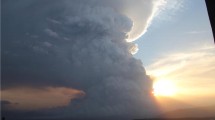Abstract
Policy responses for local and global fire management as well as international green-gas inventories depend heavily on the proper understanding of the annual fire extend as well as its spatial variation across any given study area. Proper statistical models are important tools in quantifying these fire risks. We propose Bayesian methods to model jointly the probability of ignition and fire sizes in Australia and New Zeland. The data set on which we base our model and results consists of annual observations of several meteorological and topographical explanatory variables, together with the percentage of land burned over a grid with resolution of 1° across Austalia and New Zealand. Our model and conclusions bring improvements on the results reported by Russell-Smith et al. in Int J Wildland Fire, 16:361–377 (2007) based on a similar data set.
Similar content being viewed by others
References
Anselin L, Griffith D (1988) Do spatial effects really matter in regression analysis. Pap Reg Sci Assoc 65: 11–34
Archibald S, Roy DP, van Wilgen BW, Scholes RJ (2009) What limits fire? An examination of drivers of burnt area in southern Africa. Glob Chang Biol 15(3): 613–630
Banerjee S, Gelfand A, Finley AO, Sang H (2008) Gaussian predictive process models for large spatial data sets. JRSS B 70: 825–848
Banerjee S, Carlin B, Gelfand A (2004) Hierarchical modeling and analysis for spatial data. Chapman and Hall, London
Bartholome E, Belward AS (2005) GLC2000: a new approach to global land cover mapping from earth observation data. Int J Remote Sens 26: 1959–1977
Breckle SW (2002) Walter’s vegetation of the earth—the ecological systems of the geo-biosphere. Springer, Berlin
Fotheringham AS, Brunsdon C, Charlton M (2002) Geographically weighted regression. John Wiley, New York
Gelfand A, Schmit A, Banerjee S, Firmans C (2004) Nonstationary multivariate process modeling through spatially varying coreginalization. TEST 13: 263–312
Giglio L, van der Werf GR, Randerson JT, Collatz GJ, Kasibhatla P (2006) Global estimation of burned area using MODIS active fire observations. Atmos Chem Phys 6: 957–974
Krawchuk MA, Moritz MA, Parisien M-A, Van Dorn J, Hayhoe K (2009) Global pyrogeography: the current and future distribution of wildfire. PLoS ONE 4(4): e5102. doi:10.1371/journal.pone.0005102
Legendre P (1993) Spatial autocorrelation: trouble or new paradigm. Ecology 74: 1659–1673
Lunn DJ, Thomas A, Best N, Spiegelhalter D (2000) WinBUGS—a Bayesian modelling framework: concepts, structure, and extensibility. Stat Comput 10: 325–337
Ntzoufras I (2009) Bayesian modeling using winBUGS. John wiley and Sons, New York
Russell-Smith J, Yates CP, Whitehead PJ, Smith R, Craig R, Allan GE, Thackway R, Frakes I, Cridland S, Meyer MCP, Gill AM (2007) Bushfires down under: patterns and implications of contemporary Australian landscape burning. Int J Wildland Fire 16: 361–377
Sá ACL, Pereira JMC, Mota B, Charlton M, Fotheringham AS, Barbosa PM (2009) Pyrogeography of sub-Saharan Africa: spatial non-stationarity of fire-environment relationships. J Geogr Syst under review
Sanderson EW, Jaiteh M, Levy MA, Redford KH, Wannebo AV, Woolmer G (2002) The human footprint and the last of the wild. Bioscience 52(10): 891–904
Spessa A, McBeth B, Prentice C (2005) Relationships among fire frequency, rainfall and vegetation patterns in the wet-dry tropics of northern Australia: an analysis based on NOAA-AVHRR data. Glob Ecol Biogeogr 14(5): 439–454
Thomas A, Best N, Lunn D, Arnold R, Spiegelhalter D (2004) GeoBUGS User Manual, version 1.2. http://www.mrc-bsu.cam.ac.uk/bugs/winbugs/geobugs12manual.pdf
Xie PP, Arkin PA (1997) Global precipitation: a 17-year monthly analysis based on gauge observations, satellite estimates, and numerical model outputs. Bull Am Meteor Soc 78: 2539–2558
Author information
Authors and Affiliations
Corresponding author
Additional information
This work is partially supported by FCT, POCTI and Research project PTDC/MAT/64353/2006.
Rights and permissions
About this article
Cite this article
Amaral-Turkman, M.A., Turkman, K.F., Le Page, Y. et al. Hierarchical space-time models for fire ignition and percentage of land burned by wildfires. Environ Ecol Stat 18, 601–617 (2011). https://doi.org/10.1007/s10651-010-0153-9
Received:
Revised:
Published:
Issue Date:
DOI: https://doi.org/10.1007/s10651-010-0153-9




